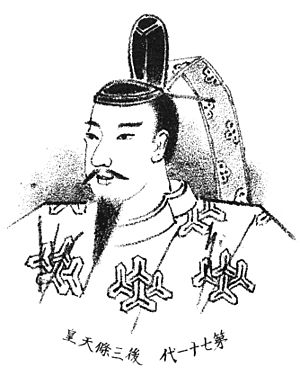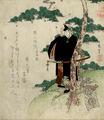Emperor Go-Sanjō facts for kids
Quick facts for kids Emperor Go-Sanjō後三条天皇 |
|||||
|---|---|---|---|---|---|
 |
|||||
| Emperor of Japan | |||||
| Reign | May 22, 1068 – January 18, 1073 | ||||
| Coronation | August 21, 1068 | ||||
| Predecessor | Go-Reizei | ||||
| Successor | Shirakawa | ||||
| Born | September 3, 1032 | ||||
| Died | June 15, 1073 (aged 40) | ||||
| Burial | Ensō-ji no misasagi (圓宗寺陵) (Kyoto) | ||||
| Spouse |
Kaoruko
(m. 1051) |
||||
| Issue |
|
||||
|
|||||
| House | Yamato | ||||
| Father | Emperor Go-Suzaku | ||||
| Mother | Teishi | ||||
Emperor Go-Sanjō (後三条天皇, Go-Sanjō-tennō) was the 71st emperor of Japan. He ruled from 1068 to 1073.
His name, "Go-Sanjō," means "Later Emperor Sanjō." He is sometimes called "Sanjō, the second." His time as emperor was very important. He helped to weaken the power of the Fujiwara clan, a powerful family that had controlled Japan for a long time. After his rule, the Fujiwara family's power continued to fade away.
Contents
About Emperor Go-Sanjō
Before he became emperor, his personal name was Takahito-shinnō (尊仁親王). He was the second son of Emperor Go-Suzaku.
His mother was Empress Sadako (禎子内親王). She was the third daughter of Emperor Sanjō. This was special because Takahito was the first emperor in 170 years whose mother was not from the powerful Fujiwara family. This meant he did not owe them loyalty. He could stand up to them and make his own decisions.
Key Events During His Rule
Since Prince Takahito was not closely related to the Fujiwara family, the powerful leader of the Fujiwara, Fujiwara no Yorimichi, did not pay much attention to him. However, Emperor Go-Suzaku decided that Takahito would be the next emperor after his older brother, Chikahito (who became Emperor Go-Reizei). Emperor Go-Reizei had no children, so when he died, Takahito became emperor.
- May 22, 1068: Emperor Go-Reizei died. His younger half-brother, Takahito, became the new emperor. This is called senso (receiving the succession). Soon after, he officially took the throne, which is called sokui.
- 1069: Emperor Go-Sanjō wanted to rule by himself, not letting the Fujiwara family control everything. He issued the Enkyū Shōen Regulation Decree. This was a new law about land ownership. He created a government office to check land records. This helped the emperor gain more control over the land.
- 1070: Go-Sanjō ordered new laws to help control the silk trade. He also worked on improving the government system.
- 1072: The old system of central government, called the Ritsuryō system, was not working well. Go-Sanjō wanted to make the Imperial Family's finances stronger. He worked to bring more money and power back to the emperor.
- January 18, 1073: After ruling for about five years, Emperor Go-Sanjō decided to step down. This is called abdication. He gave the throne to his son, who became Emperor Shirakawa.
- May 11, 1073: Go-Sanjō became a Buddhist priest. His new name as a priest was Kongō-gyō.
- June 15, 1073: The former Emperor Go-Sanjō died at the age of 40.
Go-Sanjō is buried at Ryōan-ji in Kyoto, among the "Seven Imperial Tombs." His burial place is officially called Yensō-ji no misasagi. These tombs were restored in the 19th century by Emperor Meiji.
Eras of His Reign
The years of Emperor Go-Sanjō's rule are known by different era names (called nengō):
His Family
Emperor Go-Sanjō had three main consorts (wives).
- Empress (chugū): Imperial Princess Kaoruko
- She was the daughter of Emperor Go-Ichijō.
- Consort: Fujiwara Shigeko (died 1062)
- She was the daughter of Fujiwara Kinnari.
- Children:
- Imperial Princess Satoko (1050-1131)
- Imperial Prince Sadahito, who became Emperor Shirakawa
- Imperial Princess Toshiko (1056-1132)
- Imperial Princess Yoshiko (1057-1130)
- Imperial Princess Tokushi (1060–1114), who married Emperor Horikawa
- Consort: Minamoto Motoko (1047-1134)
- She was the daughter of Minamoto Motohira.
- Children:
- Imperial Prince Sanehito (1071-1085)
- Imperial Prince Sukehito (1073-1119)
- Consort: Fujiwara Akiko, daughter of Fujiwara Yorimune
- Lady-in-waiting: Taira Chikako, daughter of Taira Tsunakuni
- Son: Fujiwara Arisuke (died 1131)
See also
 In Spanish: Go-Sanjō Tennō para niños
In Spanish: Go-Sanjō Tennō para niños
- Emperor of Japan
- List of Emperors of Japan
- Imperial cult
| Regnal titles | ||
|---|---|---|
| Preceded by Emperor Go-Reizei |
Emperor of Japan: Go-Sanjō 1068–1073 |
Succeeded by Emperor Shirakawa |
Images for kids



